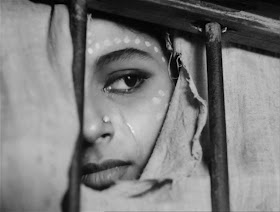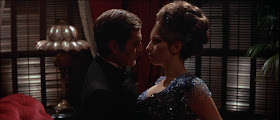Note: My review contains spoilers so that if you haven't seen the film please read with caution.
Preface: It has been pointed out by multiple critics and bloggers that the film takes place within the context of Western religion, specifically Christianity. My review and analysis takes place within that context as that is how I have viewed the film and its meaning.
Terrence Malick's newest magnum opus is a gushing, uninhibited look at life and its purpose. It's a nearly 2 1/2 hour film filled with lots of ideas, and it could have easily been hours longer. In plot, the film basically follows the summer experience of a boy named Jack. He has two younger brothers and a father and mother. He lives in a Neighborhood, which is a stand-in for a universal neighborhood of sorts, a place where one plays, learns, experiments, experiences life in all its glories and tragedies but still under the guidance and love of ones parents, so there is a safety net. Later in life, the family is stricken with the news that the middle child has passed away at age 19, from what we do not know. The mother and father clearly have their faith challenged. This is where the early reference to Job in the film's opening passage comes into play. It's also clear that Jack as a grown man, played by Sean Penn, is clearly searching in the void to fill a vacancy in his life.
Malick’s title, The Tree of Life, references the passages in Genesis 2:9, "And the Lord God made all kinds of trees grow out of the ground -- trees that were pleasing to the eye and good for food. In the middle of the garden were the tree of life and the tree of the knowledge of good and evil." It’s clear that God presented two choices to Adam and Eve and gave them the option of following their own intent, or following the way of everlasting permanence with God. Adam and Eve followed the way of “Nature” and ignored the salvation/tree of life in the garden. This of course leads to the need for grace or salvation following The Fall of Humanity in Christian theology. This is synonymous with the film’s subject matter. I believe the film is basically about the boy coming to the understanding that his parents are fallible, reaching the point in time where he cannot rely on them to be his saviors. He realizes that there is death, that life is finite, that this innocent boyhood will come to an end. His parents try as they might, but they cannot save him through their human love. He has to be saved through his own search. Jack is reminded of this through the behavior of his father and mother. Both love their children but in different ways. The father is a perfectionist and strict disciplinarian but he loves his children and teaches them that they must stand up for themselves. Mr. O'Brien wants so badly to have his children obey him though that he gets frustrated easily and has a temper. The mother is eternally loving, providing comfort, warmth, and grace, but she is meek and not able to convey the strength that the boy needs at times. Jack doesn't find complete solace in either of them and instead tries to find his own way. There's a specific moment where Jack says, "What I want to do, I can't do. I do what I hate." which seems to directly reference a passage from the Bible, Romans 7:19 where Paul says, "For what I do is not the good I want to do; no, the evil I do not want to do -- this I keep doing." It's moments like this where perhaps Malick tips his hand as to where the film's theology and philosophy lie.
There have been many readings and interpretations of the film and the characters. Some might make the assumption that The Father, Mr. O'Brien is a God figure. I can’t go down that path. Mr. O'Brien is clearly not perfect nor without sin and I can't substitute him for God in this way at all. On the flipside, if Malick were making some parallels between Mr. O'Brien and God, making him out to be a strict disciplinarian and domineering figure, then it really wouldn't fit with themes of the film regarding forgiveness and grace. Another point of contention for many, the beach sequence at the end of the film, has been claimed to be the afterlife or heaven. It does not feel like a heaven experience to me in the strict sense. In Christianity, one knows that when believers die, they go to heaven. There is no indication that the Sean Penn character dies. He clearly talks to his Dad on the phone in one instance, so we know his father is not dead either. In the film, he goes in his mind to a place of understanding and where his memories are reconciled to himself. So, I don't believe it's a heaven sequence but a spiritual birth sequence and moment of reconciliation and forgiveness. In fact, it is his moment of salvation or accepting of God's grace. The imagery used and repeated during this sequence is of entering through a doorway, which happens at least twice during this sequence. In the Bible, Mathew 7:7 reads, "Ask and it will be given to you; seek and you will find; knock and the door will be opened to you." Again, Malick's references to biblical passages are more than just coincidental here.
I think all of these spiritual overtones lead some to feel that this film is heavyhanded (where everyone would know exactly what is being said). I don't think it's heavyhanded, but more a film that is unrestrained. It is unrestrained in its efforts to display the power of creation, the comparison of father and mother, the realization of our speck of existence, childhood and the loss of innocence, the portrayal of salvation. This unrestrained quality gives the viewer a challenge in that one must view it actively. You can't just tune out, but you must meet the film on an equally active level of engagement to appreciate what Malick is trying to say.

There are some troubling aspects to interpreting the film through the lens of western Christianity though. If the film is truly a distillation of Christian themes, why does the creation sequence resemble more of what would be considered The Big Bang? There clearly is chaos in effect during the sequences and furthermore, there is more than a hint of Evolution portrayed through the development of single cells and gradually more complex organisms brought to life. I don't think that creation and The Big Bang are completely mutually exclusive, but traditional evangelical views do not espouse a belief in The Big Bang or Evolution. Does this mean that the interpretation of the film through the lens of Christianity is not valid? I'm not sure. I think it's a troubling aspect, and one I am not clear is reconcilable depending on how one views the remaining of the film.
Philosophically and spiritually, the film provides a lot to think about. But, as a film experience it holds great power as well. The sequences of childhood are probably some of the best distillations of youth ever put on film. Even the camerawork by Emmanuel Lubezki seems to have the perspective of youth imbued upon it. Everything seems to be regarded with the naïveté and the mischief of a young mind. A window is regarded from the perspective of whether it should be broken with a rock or not. A lizard is not just a reptile to marvel at, it’s something to scare your mother with. This perspective really provides the lens of credibility that the films needs to convey its aura. As for the acting in the film, I'm never one to directly provide much praise to Brad Pitt. But, his performance here really strikes the right notes and is probably his best and most nuanced performance of his career. Jessica Chastain as Mrs. O'Brien also gives a breathless and near wordless performance filled with graceful and stern looks. I'm hoping we see more of her in the future. However, the star of the film is Hunter McCracken as Jack, who steals nearly every scene he's in and is able to carry the emotional weight of the film on his young shoulders. Sean Penn though is not given nearly much to do as the adult Jack and one wonders whether there was a larger plot thread involved at one point in the film's development.

Outside of the “creation” sequence, most of what follows is similar to other Malick films in terms of its storytelling manner and are familiar to Malick-ites: Mostly wordless sequences involving individuals, distilled to actions or looks, shots of nature to convey mood and tension, and enhanced with musical interludes. All of the middle sequences are just stunning as the poetry of life unfolds in all its beauty and tragedy. However, the structure of the film is deliberately fractured, and at times nearly impenetrable. I think there is evidence of much more storyline involving Sean Penn's adult Jack. In the beach sequence we witness a woman who might be his wife and a girl who might be his daughter, but there is no attempt to explain who they are in this version of the film. There are rumors of a 4-6 hour version in the works, so it's entirely possible that the Sean Penn sequences could contain a great deal more information than we're given in the current version.
The Tree of Life is beautiful, transcendent and spiritual, but so are Malick's other films in different ways. So, I won’t go so far to say it’s his best one. I also will stop short of conveying any sense of this being the most ambitious or important film in multiple decades, as I’ve seen some call it. For me it’s no more ambitious than Lynch’s work, Von Trier's, or Kieslowski’s among others. Malick belongs to a family of filmmakers intent on conveying, in their own way, their outlook and perspective on life and the artistry of conveying it. This film is an important work that demands to be seen and should be seen by anyone interested or believing in film that is capable of grandeur. The Tree of Life is ultimately a challenging, sometimes messy, and rewarding work of cinematic art because of its ability to convey the ineffable of a spiritual journey and life itself through the medium of film. It’s as simple as that for me.




















